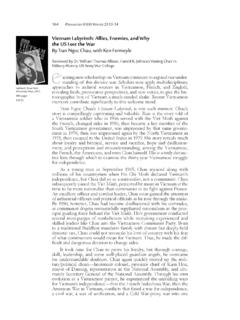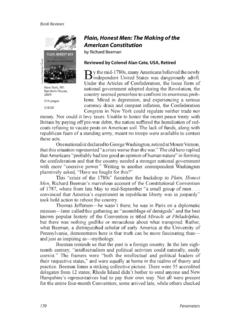Transcription of The PLA at Home and Abroad: Assessing the …
1 Roy Kamphausen, David Lai, and Andrew Scobell's The PLA at Home and Abroad The PLA at Home and Abroad: Assessing the Operational Capabilities of China's Military Courtesy of US Army Strategic Studies Institute edited by Roy Kamphausen, David Lai, and Andrew Scobell Reviewed by Richard Halloran, former foreign cor- respondent in Asia and military correspondent in Washington for The New York Times Carlisle, PA: US Army Strategic Studies have F. or two decades, American political leaders of both major parties and senior military officers of all services complained that China lacked transparency in its Institute, 2010.
2 Posture and policy on security. With due respect, but in all 645 pages candor, that lament borders on nonsense. A Westerner who $ wants to know what the Chinese are up to could begin with any one of many excellent histories to trace the strands that have culminated in the drive of the Chinese Communist Party (CCP) to rebuild the Middle Kingdom, a concept dating from the Eighth Century BC. Then the explorer could delve into books like James Lilley's China Hands, in which the author recounts his time as US ambassador in Beijing during the 1989 massacre in Tiananmen Square and scholar Susan Shirk's China: Fragile Super Power, in which she convincingly links China's internal politics with its external ambitions.
3 In particular, this excellent study entitled The PLA at Home and Abroad, which fits into a flow of unclassified books, monographs, and papers on China's military posture from the Army's Strategic Studies Institute, does much to dispel any mystery that might surround the People's Liberation Army (PLA). For a long time, American leaders have been surprised with the PLA's advances, the introduction concludes. The emergence of a much more sophisticated PLA in the coming years should not be a surprise.. This work was edited by Roy Kamphausen of the National Bureau of Asian Research who qualifies as a China hand ; David Lai, a scholar at the Strategic Studies Institute who was raised in China before becoming a natural- ized US citizen; and Andrew Scobell, another scholar and a recognized China hand at the RAND Corporation.
4 They were joined by eleven other specialists on China and evidently benefitted from wide-ranging discussions on China's military power at a conference in late 2009. As China's economy surged in the early 1990s, then-President Jiang Zemin set three guidelines for the PLA: 1) to move beyond protecting the nation's borders to winning a local war against Taiwan, 2) to shift from a manpower-intensive force to one based on technology, and 3) to fight a limited war under high-tech conditions, possibly involving hegemonic powers, with those powers to be read as the US and its allies.
5 Chinese apprehension about the strategic intent of the United States, wrote David Lai in the introduction, is the driver for much of the PLA's modernization programs and doctrinal evolution encompassing all realms of Autumn 2011 147. Book Reviews military operations from space to submarine warfare. In turn, he says, China's military modernization has deepened US apprehension about China's intent.. Moreover, all of Asia is watching the dynamics of the Sino-American relation- ship. For Beijing to assert that the PLA does not pose a threat to other Asian nations is viewed askance in other Asian capitals.
6 As might be expected, commanders of US forces in the Pacific, from Admiral Joseph Prueher in the late 1990s to Admiral Robert Willard in 2011, have repeatedly sought to assure the Chinese that the US plans no assault on China. At the same time, those commanders have sought, out of the public eye, to caution the Chinese not to miscalculate as did the Japanese when they mounted the surprise attack on Pearl Harbor on 7 December 1941. Less than four years later, Japanese delegates, their country in ruins, signed the surrender aboard the USS Missouri, now secured to a dock in Pearl Harbor.
7 Critical to understanding China's military power are relations between the CCP and the PLA, which are vastly different from civil-military relations in the United States. In the oft-cited declarations of the revolutionary leader, Mao Zedong, power grows out of the barrel of a gun and the party controls the gun. In reality, says this book, China's transformation in military affairs is tearing apart the fabric of this relationship. Against the PLA's surging autonomy, they say, the CCP is clearly fighting a losing battle.. American officers and diplomats who have dealt face-to-face with the Chinese have noted the change.
8 Where Chinese diplomats have been civil, even if taking a hard line in differing with Americans, senior Chinese officers have been personally belligerent and harsh in blaming Americans for all the problems between the two nations. On the other hand, the authors find that the increased frequency and sophistication of China's employment of military diplomacy as a tool of statecraft mirrors trends in the overall Chinese diplo- macy as the PRC [Peoples Republic of China] becomes increasingly engaged in the international community.
9 This book has two strong points to further recommend it and two nearly fatal flaws. It evinces meticulous research and rests on a wealth of solid sources, many of them Chinese. The researchers have relied heavily on what the Chinese themselves say and that has given this work an aura of authority. And throughout the book and in the endnotes are parenthetical references in the original Chinese, an added plus for those who read Chinese. The flaws: The introduction and eleven chapters are larded with military acronyms that obstruct the flow of the narrative and will almost certainly put off the nonmilitary reader who would benefit from this otherwise well-done book.
10 And there is no index, a criminal omission in a 645-page work with diverse contributors whose findings often overlap. Readers who want to compare what David Lai says in the introduction with what Paul Godwin or Dennis Blasko or Susan Puska say in later chapters are doomed to tedious, time-consuming work. Publishers who permit such flaws should be punished with the Chinese torture of a thousand cuts. 148 Parameters




